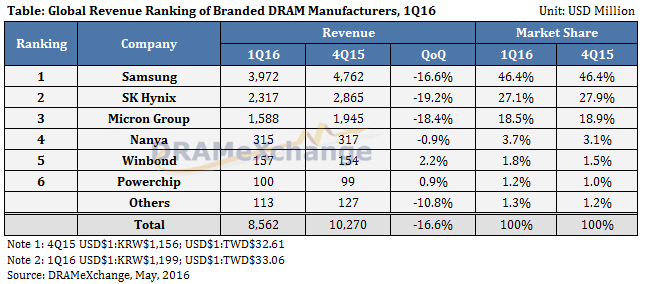Price Check Q3 2016: DRAM Prices Down Over 20% Since Early 2016
by Anton Shilov on July 25, 2016 12:01 AM ESTSamsung Retains Market Leadership
According to DRAMeXchange, the global DRAM industry earned $8.56 billion revenue in Q1 2016, down from $12.1 billion in Q1 2015 (-29.3%) and from $10.27 billion in the fourth quarter of last year (-16.6%). Analysts have stated that the dropping prices for DRAM ICs and relatively low demand for computer memory as primary reasons for the revenue declines.
With a nearly 30% year-over-year decrease, it is not surprising that all DRAM manufacturers suffered from declining revenue and dropping margins, even though the industry stayed profitable as a whole in the first quarter.
Samsung remained the world’s largest supplier of DRAM in the first quarter with 46.4% of the market (up from 43.1% in Q1 2015), not challenged by its key rivals. Meanwhile, SK Hynix commanded 27.1% of DRAM shipments in the first quarter of 2016, slightly down from the previous quarters. The third largest DRAM maker, Micron, controlled 18.5% of the planet’s DRAM sales in Q1 2016, a significant decrease from 22.5% in the same period a year before.
But Smaller Vendors Pick Up Pace
By contrast, smaller makers like Nanya, Winbond, PowerChip and some other managed to increase their shares slightly in the first quarter of this year. The analysts believe that this happened because they increased their output and could simply supply more DRAM than usual.
Wrapping everything up, it is evident that the transition to DDR4 memory is proceeding rapidly and the industry will produce more DDR4 bits than DDR3 bits later this year. As a result, DDR4 should trend towards being cheaper than DDR3 when the amount of DDR4 will significantly outpace the older technology. It is also noteworthy that Samsung will be able to greatly benefit from its 18 nm fabrication technology in the second half of this year, as its rival Micron is not expected to be ready with its 16 nm manufacturing process before Q4. Thus, Samsung may be able to sell its high-performance and/or low-power DRAM ICs at a premium.











37 Comments
View All Comments
sonicmerlin - Monday, July 25, 2016 - link
The title of the article incorrectly states "since 2015", when the text clearly states the 20% drop is from early 2016.Ian Cutress - Monday, July 25, 2016 - link
That was a mistake on my part. Updated :)Mikuni - Monday, July 25, 2016 - link
How can the fab cost so much? 12-13 billions? It would be interesting to see an article detailing the design and processes of such buildings, the machinery used etc.woggs - Monday, July 25, 2016 - link
The tools installed are the money... These are a little dated but interesting...https://www.youtube.com/watch?v=SeGqCl3YAaQ
https://www.youtube.com/watch?v=4Q_n4vdyZzc
mejobloggs - Tuesday, July 26, 2016 - link
Those videos are mind boggling, just trying to think how much technology involved in all thatAndrewJacksonZA - Monday, July 25, 2016 - link
There's a typo on the headings on the first graph: "sopt" instead of "spot"anomalydesign - Monday, July 25, 2016 - link
These findings of DDR4 prices continuing to go lower don't match with my personal experience. In ordering RAM in the past month I've come to accept that the prices are significantly higher than they were earlier in the year.After reading the article I though perhaps I was misremembering the prices, so I looked back through my order history at Newegg. I purchased multiple 16 and 32GB DDR4 kits from different brands back in April, and in each case the listed price on those kits was not only lower than the current price (by at least 10-25 percent), but they were well below the price of ANY comparable kit currently available.
So I don't know why the graphs and examples in this article don't line up with what I've experienced. I think perhaps looking at particular brands and models is part of the issue, as one that is priced at the entry level can move up, or vice versa. But unless there is a way to show prices not of a particular kit, but of the least expensive example of a given speed/capacity, I don't think these findings reflect the reality of the RAM market.
anomalydesign - Monday, July 25, 2016 - link
One example, which has gone from $110 to 152 in the past few months: http://www.newegg.com/Product/Product.aspx?Item=N8...CaedenV - Monday, July 25, 2016 - link
It could be that you have been scooping RAM up on sales and deals available at the time, and the chart prices are for the 'normal' or 'average' going price of the products.I know that for DDR3 I picked up 16GB for my home server last spring for ~$80, and then during prime day sale I picked up another 32GB for my desktop for $65. Just goes to show that charts only show part of the picture... But still, RAM is dirt cheap compared to a year or two ago!
JoeyJoJo123 - Monday, July 25, 2016 - link
No, your experience here is correct; Anandtech's reporting is incorrect.See the price graph here of a common set of DDR4-2400 set of ram with no heatspreaders over time this year.
https://pcpartpicker.com/product/kCL7YJ/gskill-mem...
Lowest RAM prices were around April~May this year, after that prices began to pick up, and today, prices sit about ~20% higher than their historical low around April~May. And this isn't the only set of RAM that had the same price swings...
See:
https://pcpartpicker.com/product/tPVBD3/corsair-me...
https://pcpartpicker.com/product/ydCrxr/gskill-mem...
https://pcpartpicker.com/product/xxs8TW/gskill-mem...
Etc...